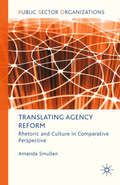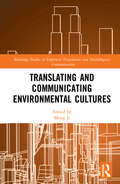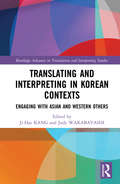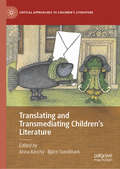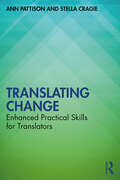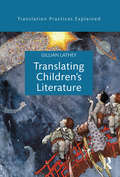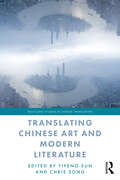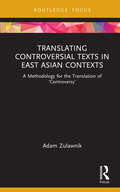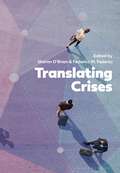- Table View
- List View
Translating Agency Reform: Rhetoric and Culture in Comparative Perspective (Public Sector Organizations)
by A. SmullenThrough comparative analysis this book examines and explains the official rhetoric of agency reform across consensus and adversarial political cultures. It traces the trajectory of talk about agency reform in The Netherlands, Sweden and Australia and identifies the national styles of speaking that mediated the agency idea.
Translating and Communicating Environmental Cultures (Routledge Studies in Empirical Translation and Multilingual Communication)
by Meng JiEnvironmental translation studies has gained momentum in recent years as a new area of research underscored by the need to communicate environmental concerns and studies across cultures. The dissemination of translated materials on environmental protection and sustainable development has played an instrumental role in transforming local culture and societies. This edited book represents an important effort to advance environmental studies by introducing the latest research on environmental translation and cross-cultural communication. Part I of the book presents the newest research on multilingual environmental resource development based at leading research institutes in Europe, Latin America, North America, and the Asia-Pacific. Part II offers original, thought-provoking linguistic, textual and cultural analyses of environmental issues in genres as diverse as literature, nature-based tourism promotion, environmental marketing, environmental documentary, and children’s reading. Chapters in this book represent original research authored by established and mid-career academics in translation studies, computer science, linguistics, and environmental studies around the world. The collection provides engaging reading and references on environmental translation and communication to a wide audience across academia.
Translating and Communicating Environmental Cultures (Routledge Studies in Empirical Translation and Multilingual Communication)
by Meng JiEnvironmental translation studies has gained momentum in recent years as a new area of research underscored by the need to communicate environmental concerns and studies across cultures. The dissemination of translated materials on environmental protection and sustainable development has played an instrumental role in transforming local culture and societies. This edited book represents an important effort to advance environmental studies by introducing the latest research on environmental translation and cross-cultural communication. Part I of the book presents the newest research on multilingual environmental resource development based at leading research institutes in Europe, Latin America, North America, and the Asia-Pacific. Part II offers original, thought-provoking linguistic, textual and cultural analyses of environmental issues in genres as diverse as literature, nature-based tourism promotion, environmental marketing, environmental documentary, and children’s reading. Chapters in this book represent original research authored by established and mid-career academics in translation studies, computer science, linguistics, and environmental studies around the world. The collection provides engaging reading and references on environmental translation and communication to a wide audience across academia.
Translating and Interpreting in Australia and New Zealand: Distance and Diversity (Routledge Advances in Translation and Interpreting Studies)
by Judy Wakabayashi and Minako O’HaganThis volume explores Australian and New Zealand experiences of translation and interpreting (T&I), with a special focus on the formative impact of geocultural contexts. Through the critical lenses of practitioners, scholars and related professionals working in and on these two countries, the contributors seek a better understanding of T&I practices and discourses in this richly multilingual and multicultural region. Building on recent work in translation and interpreting studies that extends attention to sites outside of Europe and the Americas, this volume considers the geocultural and geopolitical factors that have helped shape T&I in these Pacific neighbours, especially how the practices and conceptualization of T&I have been closely tied with immigration. Contributors examine the significant role T&I plays in everyday communication across varied sectors, including education, health, business, and legal contexts, as well as in crisis situations, cultural and creative settings, and initiatives to revitalize Indigenous languages. The book also looks to the broader implications beyond the Australian and New Zealand translationscape, making it of relevance to T&I scholars elsewhere, as well as those with an interest in Indigenous studies and minority languages.
Translating and Interpreting in Australia and New Zealand: Distance and Diversity (Routledge Advances in Translation and Interpreting Studies)
by Judy Wakabayashi Minako O'HaganThis volume explores Australian and New Zealand experiences of translation and interpreting (T&I), with a special focus on the formative impact of geocultural contexts. Through the critical lenses of practitioners, scholars and related professionals working in and on these two countries, the contributors seek a better understanding of T&I practices and discourses in this richly multilingual and multicultural region. Building on recent work in translation and interpreting studies that extends attention to sites outside of Europe and the Americas, this volume considers the geocultural and geopolitical factors that have helped shape T&I in these Pacific neighbours, especially how the practices and conceptualization of T&I have been closely tied with immigration. Contributors examine the significant role T&I plays in everyday communication across varied sectors, including education, health, business, and legal contexts, as well as in crisis situations, cultural and creative settings, and initiatives to revitalize Indigenous languages. The book also looks to the broader implications beyond the Australian and New Zealand translationscape, making it of relevance to T&I scholars elsewhere, as well as those with an interest in Indigenous studies and minority languages.
Translating and Interpreting in Korean Contexts: Engaging with Asian and Western Others (Routledge Advances in Translation and Interpreting Studies)
by Ji-Hae Kang Judy WakabayashiThe focus of this volume is on how the people of the Korean Peninsula—historically an important part of the Sinocentric world in East Asia and today a vital economic and strategic site—have negotiated oral and written interactions with their Asian neighbors and Europeans in the past and present through the mediation of translators and interpreters. These encounters have been shaped by political, social, and cultural factors, including the shared use of the Chinese writing system in East Asia for many centuries, attitudes toward other Asians and Westerners, and perceptions of Korean identity in relation to these Others. After exploring aspects of historical interactions, the volume addresses how the role and practice of translation and interpreting have recently evolved as a result of the development of digital technology, an increase in the number of immigrants, and changes in political and cultural dynamics in the region. It covers a range of historical and contemporary aspects, genres, and venues that extend beyond the common yet restrictive focus on literary translation and includes discussions of translator training and academic studies of translation and interpreting in Korea.
Translating and Interpreting in Korean Contexts: Engaging with Asian and Western Others (Routledge Advances in Translation and Interpreting Studies)
by Ji-Hae Kang Judy WakabayashiThe focus of this volume is on how the people of the Korean Peninsula—historically an important part of the Sinocentric world in East Asia and today a vital economic and strategic site—have negotiated oral and written interactions with their Asian neighbors and Europeans in the past and present through the mediation of translators and interpreters. These encounters have been shaped by political, social, and cultural factors, including the shared use of the Chinese writing system in East Asia for many centuries, attitudes toward other Asians and Westerners, and perceptions of Korean identity in relation to these Others. After exploring aspects of historical interactions, the volume addresses how the role and practice of translation and interpreting have recently evolved as a result of the development of digital technology, an increase in the number of immigrants, and changes in political and cultural dynamics in the region. It covers a range of historical and contemporary aspects, genres, and venues that extend beyond the common yet restrictive focus on literary translation and includes discussions of translator training and academic studies of translation and interpreting in Korea.
Translating and Transmediating Children’s Literature (Critical Approaches to Children's Literature)
by Anna Kérchy Björn SundmarkFrom Struwwelpeter to Peter Rabbit, from Alice to Bilbo—this collection of essays shows how the classics of children’s literature have been transformed across languages, genres, and diverse media forms. This book argues that translation regularly involves transmediation—the telling of a story across media and vice versa—and that transmediation is a specific form of translation. Beyond the classic examples, the book also takes the reader on a worldwide tour, and examines, among other things, the role of Soviet science fiction in North Korea, the ethical uses of Lego Star Wars in a Brazilian context, and the history of Latin translation in children’s literature. Bringing together scholars from more than a dozen countries and language backgrounds, these cross-disciplinary essays focus on regularly overlooked transmediation practices and terminology, such as book cover art, trans-sensory storytelling, écart, enfreakment, foreignizing domestication, and intra-cultural transformation.
Translating as a Purposeful Activity: Functionalist Approaches Explained (Translation Theories Explored)
by Christiane NordThis bestselling text is a comprehensive overview of functionalist approaches to translation in English. Christiane Nord, one of the leading figures in translation studies, explains the complexities of theories and terms in simple language with numerous examples. Covering how the theories developed, illustrations of the main ideas, and specific applications to translator training, literary translation, interpreting and ethics, Translating as a Purposeful Activity concludes with a concise review of both criticisms and perspectives for the future. Now with a Foreword by Georges Bastin and a new chapter covering the recent developments and elaborations of the theory, this is an essential text for students of translation studies and for translator training.
Translating as a Purposeful Activity: Functionalist Approaches Explained (Translation Theories Explored)
by Christiane NordThis bestselling text is a comprehensive overview of functionalist approaches to translation in English. Christiane Nord, one of the leading figures in translation studies, explains the complexities of theories and terms in simple language with numerous examples. Covering how the theories developed, illustrations of the main ideas, and specific applications to translator training, literary translation, interpreting and ethics, Translating as a Purposeful Activity concludes with a concise review of both criticisms and perspectives for the future. Now with a Foreword by Georges Bastin and a new chapter covering the recent developments and elaborations of the theory, this is an essential text for students of translation studies and for translator training.
Translating Borrowed Tongues: The Verbal Quest of Ilan Stavans (Routledge Focus on Translation and Interpreting Studies)
by MªCarmen África Vidal ClaramonteThis book sheds light on the translations of renowned semiotician, essayist, and author Ilan Stavans, elucidating the ways in which they exemplify the migrant experience and translation as the interactions of living and writing in intercultural and interlinguistic spaces. While much has been written on Stavans’ work as a writer, there has been little to date on his work as a translator, subversive in their translations of Western classics such as Don Quixote and Hamlet into Spanglish. In Stavans’ experiences as a writer and translator between languages and cultures, Vidal locates the ways in which writers and translators who have experienced migratory crises, marginalization, and exclusion adopt a hybrid, polydirectional, and multivocal approach to language seen as a threat to the status quo. The volume highlights how the case of Ilan Stavans uncovers unique insights into how migrant writers’ nonstandard use of language creates worlds predicated on deterritorialization and in-between spaces which more accurately reflect the nuances of the lived experiences of migrants. This book will be of particular interest to students and scholars in translation studies, literary translation, and Latinx literature.
Translating Borrowed Tongues: The Verbal Quest of Ilan Stavans (Routledge Focus on Translation and Interpreting Studies)
by MªCarmen África Vidal ClaramonteThis book sheds light on the translations of renowned semiotician, essayist, and author Ilan Stavans, elucidating the ways in which they exemplify the migrant experience and translation as the interactions of living and writing in intercultural and interlinguistic spaces. While much has been written on Stavans’ work as a writer, there has been little to date on his work as a translator, subversive in their translations of Western classics such as Don Quixote and Hamlet into Spanglish. In Stavans’ experiences as a writer and translator between languages and cultures, Vidal locates the ways in which writers and translators who have experienced migratory crises, marginalization, and exclusion adopt a hybrid, polydirectional, and multivocal approach to language seen as a threat to the status quo. The volume highlights how the case of Ilan Stavans uncovers unique insights into how migrant writers’ nonstandard use of language creates worlds predicated on deterritorialization and in-between spaces which more accurately reflect the nuances of the lived experiences of migrants. This book will be of particular interest to students and scholars in translation studies, literary translation, and Latinx literature.
Translating Change: Enhanced Practical Skills for Translators
by Ann Pattison Stella CragieTranslating Change explores and analyses the impact of changes in society, culture and language on the translation and interpreting process and product. It looks at how social attitudes, behaviours and values change over time, how languages respond to these changes, how these changes are reflected in the processing and production of translations and how technological change and economic uncertainty in the wake of events such as the COVID-19 pandemic and Brexit affect the translation market. The authors examine trends in language change in English, French, German, Italian and Spanish. The highly topical approach to social, cultural and language change is predominantly synchronic and pragmatic, based on tracking and analysing language changes and trends as they have developed and continue to do so. This is combined with an innovative section on developing transferable translation-related skills, including writing and rewriting, editing, abstracting, transcreation and summary writing in view of a perceived need to expand the skills portfolio of translators in a changing market and at the same time to maximise translation quality. Each chapter features Pause for Thought/activity boxes to encourage active reader participation or reflection. With exercises, discussion questions, guided further reading throughout and a glossary of key terms, this innovative textbook is key reading for both students and translators or interpreters, in training and in practice.
Translating Change: Enhanced Practical Skills for Translators
by Ann Pattison Stella CragieTranslating Change explores and analyses the impact of changes in society, culture and language on the translation and interpreting process and product. It looks at how social attitudes, behaviours and values change over time, how languages respond to these changes, how these changes are reflected in the processing and production of translations and how technological change and economic uncertainty in the wake of events such as the COVID-19 pandemic and Brexit affect the translation market. The authors examine trends in language change in English, French, German, Italian and Spanish. The highly topical approach to social, cultural and language change is predominantly synchronic and pragmatic, based on tracking and analysing language changes and trends as they have developed and continue to do so. This is combined with an innovative section on developing transferable translation-related skills, including writing and rewriting, editing, abstracting, transcreation and summary writing in view of a perceived need to expand the skills portfolio of translators in a changing market and at the same time to maximise translation quality. Each chapter features Pause for Thought/activity boxes to encourage active reader participation or reflection. With exercises, discussion questions, guided further reading throughout and a glossary of key terms, this innovative textbook is key reading for both students and translators or interpreters, in training and in practice.
Translating Children's Literature (Translation Practices Explained)
by Gillian LatheyTranslating Children’s Literature is an exploration of the many developmental and linguistic issues related to writing and translating for children, an audience that spans a period of enormous intellectual progress and affective change from birth to adolescence. Lathey looks at a broad range of children’s literature, from prose fiction to poetry and picture books. Each of the seven chapters addresses a different aspect of translation for children, covering: · Narrative style and the challenges of translating the child’s voice; · The translation of cultural markers for young readers; · Translation of the modern picture book; · Dialogue, dialect and street language in modern children’s literature; · Read-aloud qualities, wordplay, onomatopoeia and the translation of children’s poetry; · Retranslation, retelling and reworking; · The role of translation for children within the global publishing and translation industries. This is the first practical guide to address all aspects of translating children’s literature, featuring extracts from commentaries and interviews with published translators of children’s literature, as well as examples and case studies across a range of languages and texts. Each chapter includes a set of questions and exercises for students. Translating Children’s Literature is essential reading for professional translators, researchers and students on courses in translation studies or children’s literature.
Translating Children's Literature (Translation Practices Explained)
by Gillian LatheyTranslating Children’s Literature is an exploration of the many developmental and linguistic issues related to writing and translating for children, an audience that spans a period of enormous intellectual progress and affective change from birth to adolescence. Lathey looks at a broad range of children’s literature, from prose fiction to poetry and picture books. Each of the seven chapters addresses a different aspect of translation for children, covering: · Narrative style and the challenges of translating the child’s voice; · The translation of cultural markers for young readers; · Translation of the modern picture book; · Dialogue, dialect and street language in modern children’s literature; · Read-aloud qualities, wordplay, onomatopoeia and the translation of children’s poetry; · Retranslation, retelling and reworking; · The role of translation for children within the global publishing and translation industries. This is the first practical guide to address all aspects of translating children’s literature, featuring extracts from commentaries and interviews with published translators of children’s literature, as well as examples and case studies across a range of languages and texts. Each chapter includes a set of questions and exercises for students. Translating Children’s Literature is essential reading for professional translators, researchers and students on courses in translation studies or children’s literature.
Translating Chinese Art and Modern Literature (Routledge Studies in Chinese Translation)
by Yifeng Sun Chris SongTranslating Chinese Art and Modern Literature examines issues in cross-cultural dialogue in connection with translation and modern Chinese art and literature from interdisciplinary perspectives. This comprises the text-image dialogue in the context of Chinese modernity, and cross-cultural interaction between modern literature in Chinese and other literatures. This edited collection approaches these issues with discrete foci and approaches, and the ten chapters in this volume are to be divided into two distinct parts. The first part highlights the mutual effects between literary texts and visual images in the media of book, painting, and film, and the second part includes contributions by scholars of literary translation.
Translating Chinese Art and Modern Literature (Routledge Studies in Chinese Translation)
by Yifeng Sun Chris SongTranslating Chinese Art and Modern Literature examines issues in cross-cultural dialogue in connection with translation and modern Chinese art and literature from interdisciplinary perspectives. This comprises the text-image dialogue in the context of Chinese modernity, and cross-cultural interaction between modern literature in Chinese and other literatures. This edited collection approaches these issues with discrete foci and approaches, and the ten chapters in this volume are to be divided into two distinct parts. The first part highlights the mutual effects between literary texts and visual images in the media of book, painting, and film, and the second part includes contributions by scholars of literary translation.
Translating Chinese Culture: The process of Chinese--English translation
by Valerie Pellatt Eric T. Liu Yalta Ya-Yun ChenTranslating Chinese Culture is an innovative and comprehensive coursebook which addresses the issue of translating concepts of culture. Based on the framework of schema building, the course offers helpful guidance on how to get inside the mind of the Chinese author, how to understand what he or she is telling the Chinese-speaking audience, and how to convey this to an English speaking audience. A wide range of authentic texts relating to different aspects of Chinese culture and aesthetics are presented throughout, followed by close reading discussions of how these practices are executed and how the aesthetics are perceived among Chinese artists, writers and readers. Also taken into consideration are the mode, audience and destination of the texts. Ideas are applied from linguistics and translation studies and each discussion is reinforced with a wide variety of practical and engaging exercises. Thought-provoking yet highly accessible, Translating Chinese Culture will be essential reading for advanced undergraduates and postgraduate students of Translation and Chinese Studies. It will also appeal to a wide range of language studies and tutors through its stimulating discussion of the principles and purposes of translation.
Translating Chinese Culture: The process of Chinese--English translation
by Valerie Pellatt Eric T. Liu Yalta Ya-Yun ChenTranslating Chinese Culture is an innovative and comprehensive coursebook which addresses the issue of translating concepts of culture. Based on the framework of schema building, the course offers helpful guidance on how to get inside the mind of the Chinese author, how to understand what he or she is telling the Chinese-speaking audience, and how to convey this to an English speaking audience. A wide range of authentic texts relating to different aspects of Chinese culture and aesthetics are presented throughout, followed by close reading discussions of how these practices are executed and how the aesthetics are perceived among Chinese artists, writers and readers. Also taken into consideration are the mode, audience and destination of the texts. Ideas are applied from linguistics and translation studies and each discussion is reinforced with a wide variety of practical and engaging exercises. Thought-provoking yet highly accessible, Translating Chinese Culture will be essential reading for advanced undergraduates and postgraduate students of Translation and Chinese Studies. It will also appeal to a wide range of language studies and tutors through its stimulating discussion of the principles and purposes of translation.
Translating Chinese Fiction: Multiple Voices and Cognitive Translatology
by Tan YeshengDrawing on the cognitive translatological paradigm, this book introduces a situation-embedded cognitive construction model of translation and explores the thinking portfolios of British and American sinologists-cum-translators to re-examine their multiple voices and cognition in translating Chinese fiction.By placing sinologists-cum-translators in the same discourse space, the study transcends the limitations of previous case studies and offers a comprehensive cognitive panorama of how Chinese novels are rendered. The author explores the challenges and difficulties of translating Chinese fiction from the insider perspectives of British and American sinologists, and cross-validates their multiple voices by aligning them with cross-cultural communication scenarios. Based on the cognitive construction model of translation, the book provides a systematic review of the translation thoughts and ideas of the community of sinologists in terms of linguistic conventions, narrative styles, contextual and cultural frames, readership categories and metaphorical models of translation. It envisions a new research path to enhance empirical research on translators' cognition in a dynamic translation ecosystem. The title will be an essential read for students and scholars of translation studies and Chinese studies. It will also appeal to translators and researchers interested in cognitive stylistics, literary studies and intercultural communication studies.
Translating Chinese Fiction: Multiple Voices and Cognitive Translatology
by Tan YeshengDrawing on the cognitive translatological paradigm, this book introduces a situation-embedded cognitive construction model of translation and explores the thinking portfolios of British and American sinologists-cum-translators to re-examine their multiple voices and cognition in translating Chinese fiction.By placing sinologists-cum-translators in the same discourse space, the study transcends the limitations of previous case studies and offers a comprehensive cognitive panorama of how Chinese novels are rendered. The author explores the challenges and difficulties of translating Chinese fiction from the insider perspectives of British and American sinologists, and cross-validates their multiple voices by aligning them with cross-cultural communication scenarios. Based on the cognitive construction model of translation, the book provides a systematic review of the translation thoughts and ideas of the community of sinologists in terms of linguistic conventions, narrative styles, contextual and cultural frames, readership categories and metaphorical models of translation. It envisions a new research path to enhance empirical research on translators' cognition in a dynamic translation ecosystem. The title will be an essential read for students and scholars of translation studies and Chinese studies. It will also appeal to translators and researchers interested in cognitive stylistics, literary studies and intercultural communication studies.
Translating Controversial Texts in East Asian Contexts: A Methodology for the Translation of ‘Controversy’ (Routledge Advances in Translation and Interpreting Studies)
by Adam ZulawnikZulawnik focuses on the broad concept of ‘controversy’ and issues pertaining to the translation of politically and historically controversial texts in East Asia. The research methodology is exemplified through a case study in the form of the author’s translation of the best-selling Japanese graphic novel (manga) Manga Kenkanryū (Hate Hallyu: The Comic) by Sharin Yamano (2005), a work that has been problematised as an attack on South Korean culture and the Korean Wave. Issues analysed and discussed in the research include translation risk, ethics, a detailed methodology for the translation of so-called controversial texts exemplified through numerous thematically divided examples from the translation of the chosen Japanese text, as well as examples from a Korean language equivalent (Manhwa Hyeomillyu – Hate Japanese Wave), and definition and contextualisation of the concept of ‘controversy’. There has been limited research in the field of translation studies, which seeks to exemplify potential pragmatic approaches for the translation of politically-charged texts, particularly in multi-modal texts such as the graphic novel. It is hoped that Zulawnik’s research will serve both as a valuable source when examining South Korea–Japan relations and a theoretical and methodological base for further research and the development of an online augmented translation space with devices specifically suited for the translation of multi-modal texts such as – but not limited to – graphic novels and visual encyclopaedias.
Translating Controversial Texts in East Asian Contexts: A Methodology for the Translation of ‘Controversy’ (Routledge Advances in Translation and Interpreting Studies)
by Adam ZulawnikZulawnik focuses on the broad concept of ‘controversy’ and issues pertaining to the translation of politically and historically controversial texts in East Asia. The research methodology is exemplified through a case study in the form of the author’s translation of the best-selling Japanese graphic novel (manga) Manga Kenkanryū (Hate Hallyu: The Comic) by Sharin Yamano (2005), a work that has been problematised as an attack on South Korean culture and the Korean Wave. Issues analysed and discussed in the research include translation risk, ethics, a detailed methodology for the translation of so-called controversial texts exemplified through numerous thematically divided examples from the translation of the chosen Japanese text, as well as examples from a Korean language equivalent (Manhwa Hyeomillyu – Hate Japanese Wave), and definition and contextualisation of the concept of ‘controversy’. There has been limited research in the field of translation studies, which seeks to exemplify potential pragmatic approaches for the translation of politically-charged texts, particularly in multi-modal texts such as the graphic novel. It is hoped that Zulawnik’s research will serve both as a valuable source when examining South Korea–Japan relations and a theoretical and methodological base for further research and the development of an online augmented translation space with devices specifically suited for the translation of multi-modal texts such as – but not limited to – graphic novels and visual encyclopaedias.
Translating Crises
by Sharon O’Brien and Federico M. FedericiTranslating and interpreting in crises is emotionally and cognitively demanding, with crisis communication in intercultural and multilingual disaster settings relying on a multitude of cross-cultural mediators and ever-emerging new technologies. This volume explores the challenges and demands involved in translating crises and the ways in which people, technologies and organisations look for effective, impactful solutions to the communicative problems.Problematising the major issues, but also providing solutions and recommendations, chapters reflect on and evaluate the role of translation and interpreting in crisis settings. Covering a diverse range of situations from across the globe, such as health emergencies, severe weather events, earthquakes, terrorist attacks, conflicts, and mass migration, this volume analyses practices and investigates the effectiveness of current approaches and communication strategies. The book considers perspectives, from interpreting specialists, educators, emergency doctors, healthcare professionals, psychologists, and members of key NGOs, to reflect the complex and multifaceted nature of crisis communication. Placing an emphasis on lessons learnt and innovative solutions, Translating Crises points the way towards more effective multilingual emergency communication in future crises.
